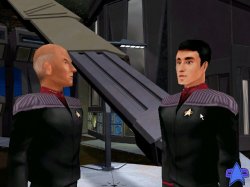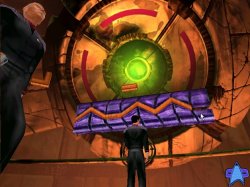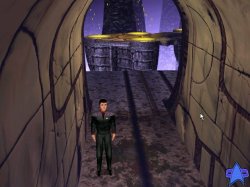|
Star Trek: Hidden Evil
 Everything I needed to know about life I learned from "Star Trek". From that statement I think it's needless to say that I'm a Trekker from way back (back to the original series), and note I said Trekker not Trekkie.
I take my Star Trek seriously and am not the glassy-eyed type of fan who will buy anything with the title "Star Trek" attached to it, so no corny fake pointy ears or T shirts of Spock in lipstick wearing a dominatrix costume with the words "Beat me up Scotty" printed over the top, for me. True to Star Trek, this game melds "Action" and puzzle solving properties in a natural flow. Labelled "Action/Adventure" Hidden Evil is light on the "Adventure" and heavy on the "Action". It was released when a barrage of Star Trek games hit the stores, and I must say, if you're looking for more than a shoot-em, blast-em game or something other than a war game, yet want something more lively than a pure adventure game, then this might be the one for you.
The story is loosely based on the movie title "Star Trek: Insurrection" and the game is set some time thereafter. You play the part of a young Ensign, Sovok, a Human who has trained previously on the planet Vulcan and is newly posted on the space station Outpost 40. You're assigned to assist Captain Picard and the crew of the Star Ship Enterprise with an archaeological dig on the planet Ba'ku. Of course, unforseen events occur and the action begins ... and action there is aplenty. Everything I needed to know about life I learned from "Star Trek". From that statement I think it's needless to say that I'm a Trekker from way back (back to the original series), and note I said Trekker not Trekkie.
I take my Star Trek seriously and am not the glassy-eyed type of fan who will buy anything with the title "Star Trek" attached to it, so no corny fake pointy ears or T shirts of Spock in lipstick wearing a dominatrix costume with the words "Beat me up Scotty" printed over the top, for me. True to Star Trek, this game melds "Action" and puzzle solving properties in a natural flow. Labelled "Action/Adventure" Hidden Evil is light on the "Adventure" and heavy on the "Action". It was released when a barrage of Star Trek games hit the stores, and I must say, if you're looking for more than a shoot-em, blast-em game or something other than a war game, yet want something more lively than a pure adventure game, then this might be the one for you.
The story is loosely based on the movie title "Star Trek: Insurrection" and the game is set some time thereafter. You play the part of a young Ensign, Sovok, a Human who has trained previously on the planet Vulcan and is newly posted on the space station Outpost 40. You're assigned to assist Captain Picard and the crew of the Star Ship Enterprise with an archaeological dig on the planet Ba'ku. Of course, unforseen events occur and the action begins ... and action there is aplenty.
 Before you begin you have to pass two short training events in the holodeck. First you must sneak up on a Romulan guard and render him harmless by performing the Vulcan nerve pinch.
Sounds easy but with a character to manoeuvre on screen, coupled with no mouse control and a swinging view it becomes difficult. First you have to become accustomed to keyboard controls but, if like myself, you're not a great fan of keyboard action games, the whole thing is trial and error for a while. For example, you may enter a room and see Sovok face you, but once you move him forwards the view swings and suddenly you might be side on or behind him. Also sneaking up isn't easy as the guard may decide to move on and then you have to catch up to him and re-position Sovok all over again and if you overshoot your mark you may bump him and then the jig is up and you have to restart. Yes restart, the whole game, unless of course you saved right after the conversation between Sovok and his Vulcan mentor. Once saved, it took me five attempts before I succeeded in the nerve pinch. You have to be standing at the right distance and the right place behind the Romulan to succeed, and timing is crucial.
Once you pass the Vulcan nerve pinch you have a short trial at shooting robot drones that fly at you. This I found much easier than the nerve pinch to master. With phaser equipped, and Sovok turned facing the enemy an automatic crosshair appears and all you need to do is press the spacebar to fire your phaser. Only once all the drones are destroyed may you continue on to what I would consider the real game. Before you begin you have to pass two short training events in the holodeck. First you must sneak up on a Romulan guard and render him harmless by performing the Vulcan nerve pinch.
Sounds easy but with a character to manoeuvre on screen, coupled with no mouse control and a swinging view it becomes difficult. First you have to become accustomed to keyboard controls but, if like myself, you're not a great fan of keyboard action games, the whole thing is trial and error for a while. For example, you may enter a room and see Sovok face you, but once you move him forwards the view swings and suddenly you might be side on or behind him. Also sneaking up isn't easy as the guard may decide to move on and then you have to catch up to him and re-position Sovok all over again and if you overshoot your mark you may bump him and then the jig is up and you have to restart. Yes restart, the whole game, unless of course you saved right after the conversation between Sovok and his Vulcan mentor. Once saved, it took me five attempts before I succeeded in the nerve pinch. You have to be standing at the right distance and the right place behind the Romulan to succeed, and timing is crucial.
Once you pass the Vulcan nerve pinch you have a short trial at shooting robot drones that fly at you. This I found much easier than the nerve pinch to master. With phaser equipped, and Sovok turned facing the enemy an automatic crosshair appears and all you need to do is press the spacebar to fire your phaser. Only once all the drones are destroyed may you continue on to what I would consider the real game.
 The story is fast paced and credible to the Star Trek universe, and the puzzles are entertaining if not too taxing. Interaction with the Enterprise crew is spontaneous with good quality voice acting, which it ought to be as it has two of the original actors from the Television show: Star Trek, The Next Generation. Patrick Stewart who plays Captain Jean-Luc Picard and Brent Spiner who plays the part of the Android, Commander Data.
Most of the time you can contact Picard or Data on your communicator or your Comm Badge if you're stuck and they will give you clues on how to get out of sticky situations. The DNA sampler is used more than once to solve a puzzle, and after finding certain keys and solving simple shape slotting puzzles, you're able to access different sections of the catacombs beneath the planet's surface. The use of the Tricorder also gives you handy information if you're stuck and not too sure on how to proceed past a forcefield.
The animated characters of Data and Picard are recognisable if not terribly accurate. Overall the graphics are fair and not at all boring or too repetitive. Data has some amusing things to say although his joke about the Cardassian and the Ferengi was definitely not a highlight of the game. The lack of a text option is a detriment, however, as sometimes speech sequences are drowned out by music and sound effects and I found myself straining to hear what was being said.
There is a lot to explore and the game has various environments throughout to keep you entertained, with the story broken into parts. You start off on the planet Ba'ku, continue onto the space station and finish off on the Enterprise. You can't really get lost, as Hidden Evil is set out so you can read your mission briefing if you forget what you were supposed to do.
Saving often is crucial as poor Ensign Sovok died an untimely death at my hands on a number of occasions. It wasn't until the second half of the game before I found I needed to use the Vulcan nerve pinch. Then it became apparent why I had to master it at the start as there were a number of Romulans to overpower in this manner. As I said before, saving often is a must. Poor Sovok died mostly due to my not being able to move quickly enough between using an object and returning to use the phaser, even though there are short cut keys at hand.
Hidden Evil is a fun (if sometimes frustrating) game if you are looking for a light adventure. Your ability with keyboard controls will probably make or break the game, but with perseverance even I managed to get through it without too much trouble. Even though there is a lot of action involved it does stay within the boundaries of using only necessary violence to overcome a greater evil. The maker of Star Trek, Gene Roddenberry would be pleased with the story that has a warning of the danger of power and knowledge falling into the wrong hands. The story is fast paced and credible to the Star Trek universe, and the puzzles are entertaining if not too taxing. Interaction with the Enterprise crew is spontaneous with good quality voice acting, which it ought to be as it has two of the original actors from the Television show: Star Trek, The Next Generation. Patrick Stewart who plays Captain Jean-Luc Picard and Brent Spiner who plays the part of the Android, Commander Data.
Most of the time you can contact Picard or Data on your communicator or your Comm Badge if you're stuck and they will give you clues on how to get out of sticky situations. The DNA sampler is used more than once to solve a puzzle, and after finding certain keys and solving simple shape slotting puzzles, you're able to access different sections of the catacombs beneath the planet's surface. The use of the Tricorder also gives you handy information if you're stuck and not too sure on how to proceed past a forcefield.
The animated characters of Data and Picard are recognisable if not terribly accurate. Overall the graphics are fair and not at all boring or too repetitive. Data has some amusing things to say although his joke about the Cardassian and the Ferengi was definitely not a highlight of the game. The lack of a text option is a detriment, however, as sometimes speech sequences are drowned out by music and sound effects and I found myself straining to hear what was being said.
There is a lot to explore and the game has various environments throughout to keep you entertained, with the story broken into parts. You start off on the planet Ba'ku, continue onto the space station and finish off on the Enterprise. You can't really get lost, as Hidden Evil is set out so you can read your mission briefing if you forget what you were supposed to do.
Saving often is crucial as poor Ensign Sovok died an untimely death at my hands on a number of occasions. It wasn't until the second half of the game before I found I needed to use the Vulcan nerve pinch. Then it became apparent why I had to master it at the start as there were a number of Romulans to overpower in this manner. As I said before, saving often is a must. Poor Sovok died mostly due to my not being able to move quickly enough between using an object and returning to use the phaser, even though there are short cut keys at hand.
Hidden Evil is a fun (if sometimes frustrating) game if you are looking for a light adventure. Your ability with keyboard controls will probably make or break the game, but with perseverance even I managed to get through it without too much trouble. Even though there is a lot of action involved it does stay within the boundaries of using only necessary violence to overcome a greater evil. The maker of Star Trek, Gene Roddenberry would be pleased with the story that has a warning of the danger of power and knowledge falling into the wrong hands.
Copyright © Mary Rose Fox 2004.
All rights reserved.
System Requirements:
Windows 95/98, Pentium 200 MHz, 32 MB RAM, 225 MB of uncompressed disk space for game files plus 80MB for the Windows swap file, Quad-speed CD-ROM drive, DirectX 7 compatible 16-bit High Color video card with minimum 4 MB RAM, DirectX 7 compatible sound card and drivers. RECOMMENDED, BUT NOT REQUIRED: DirectX 7 (Direct 3D) compatible 3D Accelerator Card.
|
